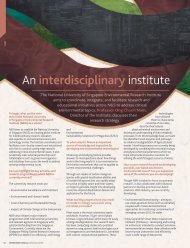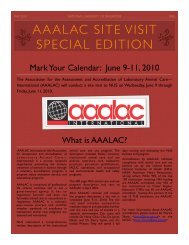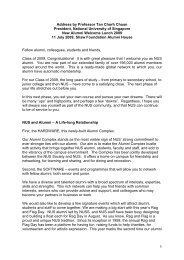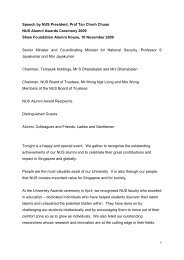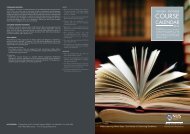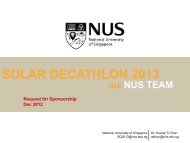Exhibition brochure - National University of Singapore
Exhibition brochure - National University of Singapore
Exhibition brochure - National University of Singapore
Create successful ePaper yourself
Turn your PDF publications into a flip-book with our unique Google optimized e-Paper software.
KEBON<br />
INDAH<br />
1<br />
MINTIO & KABUL,<br />
KELOMPOK BATIK TULIS SIDO LUHUR,<br />
COLLABORATION
Published on the occasion <strong>of</strong> the exhibition<br />
Kebon Indah<br />
Mintio & Kabul, Kelompok Batik Tulis Sido Luhur, Collaboration<br />
CONTENTS<br />
Official opening 26 September 2013<br />
Acknowledgements 2<br />
Curation<br />
Collections and Logistics<br />
Conservation<br />
Programmes<br />
Curatorial Intern<br />
Foo Su Ling<br />
Francis Wong Chin Wee<br />
The Conservation Studio<br />
Trina Bong<br />
Cindy Lin<br />
Foreword 3<br />
Ahmad Mashadi<br />
Art, Community, Collaboration 4<br />
Foo Su Ling<br />
Published by<br />
NUS Museum<br />
NUS Centre For the Arts<br />
<strong>University</strong> Cultural Centre<br />
50 Kent Ridge Crescent<br />
<strong>National</strong> <strong>University</strong> <strong>of</strong> <strong>Singapore</strong><br />
<strong>Singapore</strong> 119279<br />
Centering the Marginal: Batik<br />
Workers in Indonesia 15<br />
Amalinda Savirani<br />
Artworks 18<br />
Copyright © 2013 NUS Museum<br />
All rights reserved
2<br />
ACKNOWLEDGEMENTS<br />
This exhibition displays a set <strong>of</strong> artworks which combines the tradition <strong>of</strong> batik<br />
making with portrait photography. It was conceived as part <strong>of</strong> NUS Museum’s<br />
current exploration into the theme <strong>of</strong> portraiture which includes the exhibition<br />
Dressing the Baba (5 December 2012 – 31 July 2013), the Presenting Portraiture<br />
talk series, and a forthcoming exhibition at NUS Museum. This selection from<br />
the Malam Di Jari Kita series enables us to widen the discussion from a 19 th /early<br />
20 th century focus to encompass contemporary exercises in the representation<br />
<strong>of</strong> self and others. For this, we thank Ms Agnes Tan, founding donor <strong>of</strong> NUS<br />
Baba House, for the donation <strong>of</strong> the Malam Di Jari Kita artworks. We are also<br />
grateful to Mr Peter Lee, honorary curator <strong>of</strong> NUS Baba House and an avid<br />
researcher and collector <strong>of</strong> batik textiles, for introducing the set <strong>of</strong> artworks to<br />
NUS Museum.<br />
The artworks were produced by artists Samantha Tio (Mintio) and Budi Agung<br />
Kuswara (Kabul) working hand in hand with batik practitioners Ibu Suminah<br />
and Pak Sukardi. We would like to express our gratitude for their co-operation<br />
towards the development <strong>of</strong> this exhibition. We also thank batik makers Ibu<br />
Tri Sugiarti, Ibu Tukinem, Ibu Tuti, Mbah Medi, Mbak Surani and Mbak Yamtini<br />
– their reflections <strong>of</strong>fered us valuable insights into the Malam Di Jari Kita<br />
project from a participant’s viewpoint. Thanks also to Kabul for interpreting the<br />
conversations.<br />
Our appreciations also go to Ms Amalinda Savirani for her essay contribution,<br />
and to Ms Kamielah Khairoullah for translating the original information about the<br />
artworks from Bahasa Indonesia to English.
FOREWORD<br />
3<br />
AHMAD MASHADI<br />
The exhibition features a series <strong>of</strong> textiles produced<br />
combining photographic and batik techniques, an art<br />
project initiated by contemporary artists Samantha<br />
Tio (Mintio) and Budi Agung Kuswara (Kabul) in 2011,<br />
and developed with the batik makers <strong>of</strong> Sido Luhur<br />
based in Kebon Indah,Central Java. As entrepreneurs<br />
<strong>of</strong> Sido Luhur, Ibu Suminah and her husband Bapak<br />
Sukardi took on principal roles in discussions with the<br />
artists, and directing and participating in production<br />
processes alongside other batik makers. For the<br />
contemporary artists, the project is conceptually framed<br />
within the question <strong>of</strong> representation and agency, using<br />
portrait photography as an initial device onto which<br />
perspectives <strong>of</strong> self are engaged and interrogated. As<br />
aims, these enter into a complexity where perspectives,<br />
motivations and eventual responses <strong>of</strong> the batik makers<br />
generate dynamics <strong>of</strong> mediation and exchange; as<br />
encounters between l<strong>of</strong>tiness <strong>of</strong> activism and efficacy <strong>of</strong><br />
predicament.<br />
Two essays accompany this modest publication. The first by Amalinda Savirani<br />
explores the world <strong>of</strong> batik communities in Central Java, Indonesia, in particular<br />
the status <strong>of</strong> the batik workers relative to efforts in promoting batik products and<br />
their successes, positioning the collaboration as ways to ‘exert the existence’ <strong>of</strong><br />
the batik makers. The second, by curator Foo Su Ling, explores the interactions<br />
and exchanges that took place between artists and batik makers, as attempts<br />
to examine the varied motivations<br />
and speculate ways in which diverse<br />
practices and their conditions interact<br />
to transform attitudes and regard,<br />
not necessarily affecting economic<br />
change, but as the necessary creation<br />
<strong>of</strong> an indeterminate space to construct<br />
narratives and prospect individual<br />
directions.<br />
These works are generously donated<br />
by Ms Agnes Tan. The NUS Museum<br />
and the Baba House are grateful for<br />
her ongoing support through which<br />
we hope to continue to develop<br />
our programmes that facilitate the<br />
appreciation and awareness into<br />
<strong>Singapore</strong>an and regional heritage and<br />
culture. We thank Samantha Tio, Budi<br />
Agung Kuswara, and the batik makers<br />
<strong>of</strong> Kebon Indah – Ibu Suminah, Bapak<br />
Sukardi, Ibu Tri Sugiarti Ibu Tukinem,<br />
Ibu Tuti, Mbah Medi, Mbak Surani,<br />
Mbak Yamtini and others – for their<br />
kind cooperation in the development<br />
<strong>of</strong> this exhibition. We also thank Ms<br />
Savirani for her essay contribution to<br />
this publication.<br />
Ahmad Mashadi<br />
Head, NUS Museum
4<br />
ART, COMMUNITY,<br />
COLLABORATION<br />
FOO SU LING<br />
Malam Di Jari Kita (The Wax On Our Fingers) is<br />
a series <strong>of</strong> works resulting from the collaborative<br />
efforts <strong>of</strong> <strong>Singapore</strong> photographer Samantha Tio<br />
(Mintio), Indonesian contemporary artist Budi<br />
Agung Kuswara (Kabul) and batik makers <strong>of</strong><br />
the Sido Luhur group from the village <strong>of</strong> Kebon<br />
Indah in Central Java’s Bayat region. The series<br />
consists <strong>of</strong> eight artworks – four individual<br />
pieces, two diptych, a triptych and a quadtych<br />
– which combine the traditional art <strong>of</strong> batik with<br />
contemporary photography. In Bahasa Indonesia,<br />
malam translates to ‘night’ but as a play <strong>of</strong> sound<br />
in the Javanese language, it also refers to ‘wax’, a<br />
fundamental material in batik production.<br />
representing their attire. In the final<br />
stage <strong>of</strong> the process, the cyanotype<br />
technique is used to fill the silhouette<br />
with the photographed image <strong>of</strong> the<br />
batik maker.<br />
Focusing on the interactions between<br />
Mintio and Kabul with the batik<br />
makers <strong>of</strong> Kebon Indah, this essay<br />
examines the artistic and social<br />
dynamics between contemporary<br />
artists and traditional craft community,<br />
the outcomes, and considers the<br />
fluid, <strong>of</strong>ten unpredictable nature <strong>of</strong><br />
such community-based art initiatives.<br />
The terms ‘artist’ and ‘maker’ and<br />
their attendant categories <strong>of</strong> ‘art’<br />
and ‘craft’, prompts considerations<br />
into their comparability, relative<br />
status, value, and also the question<br />
<strong>of</strong> authorship. Where the lines that<br />
divide such categories are blurred, in<br />
this case through the proposition <strong>of</strong><br />
a ‘collaboration’, in what ways can<br />
the destabilizing impact be rendered<br />
productive? Can ‘collaboration’<br />
be conceived here as a device in<br />
democratizing prevailing approaches<br />
in the production and reception <strong>of</strong><br />
art, <strong>of</strong>fering insights into the shift in
artistic practice away from object<br />
production to outcomes that demand<br />
a framework <strong>of</strong> inquiry beyond the<br />
paradigm defined by ‘art’ and ‘craft’?<br />
Further, the term ‘community’ and<br />
its inference to a hermetic society<br />
bound by tradition and continuity<br />
deserves scrutiny, for it is not<br />
impervious to shifts in taste and the<br />
introduction <strong>of</strong> newer technologies to<br />
which it has the agency to respond<br />
through aesthetic choices, and<br />
economic decisions on scale and<br />
viability. In the sections that follow,<br />
we contemplate how this agency is<br />
expressed through an encounter with<br />
contemporary artists such as Mintio<br />
and Kabul, and how Malam Di Jari Kita<br />
contributes to ongoing discussions<br />
on the significance <strong>of</strong> collaborative art<br />
practices and the social and aesthetic<br />
values they generate 1 .<br />
Each artwork in Malam Di Jari Kita<br />
is also a batik piece, linking it to a<br />
category <strong>of</strong> cultural material with a<br />
history <strong>of</strong> association with locales and<br />
communities; mode <strong>of</strong> production;<br />
circulation and use; and encounters<br />
with modernity, transformations and<br />
changing ecologies <strong>of</strong> the market.<br />
As part <strong>of</strong> a broader category <strong>of</strong><br />
Southeast Asian art and folk textiles,<br />
batik formed part <strong>of</strong> an emerging<br />
discipline in the 1960s initiated by<br />
William Willetts during his tenure at<br />
the <strong>University</strong> <strong>of</strong> <strong>Singapore</strong> (renamed<br />
from <strong>University</strong> <strong>of</strong> Malaya in 1962).<br />
Willetts added village cloth as a<br />
category to the Museum’s collection<br />
at a time when there was little regard<br />
for crafts in museological discourses 2 .<br />
Art historian T.K. Sabapathy argues<br />
that with the deliberate focus on craft<br />
traditions, Willetts had ‘sought fresh<br />
criteria for museum acquisitions and<br />
widened the base <strong>of</strong> art historical<br />
scholarship to include a broad<br />
spectrum <strong>of</strong> material cultures’ 3 . As<br />
the beneficiary <strong>of</strong> Malam Di Jari<br />
Kita – artworks which innovatively<br />
combine a craft tradition (batik) with a<br />
contemporary artform (photography)<br />
– NUS Museum is presented the<br />
opportunity to engage Willetts’ spirit <strong>of</strong><br />
bringing into the collection ‘relatively<br />
unknown’ materials with the potential<br />
<strong>of</strong> opening up fresh discussions on art<br />
and museology.<br />
Willetts<br />
recognized that<br />
as a cultural<br />
material,<br />
textiles have the<br />
capacity to foster<br />
awareness <strong>of</strong> the<br />
social, cultural<br />
and economic<br />
lives <strong>of</strong> societies<br />
that produce<br />
them. In 1964,<br />
he curated the<br />
exhibition Indian<br />
Textiles which<br />
included an<br />
accompanying<br />
catalogue detailing his observations<br />
<strong>of</strong> the processes by which different<br />
communities produce and pattern<br />
textiles. He also includes brief<br />
comments on the economics <strong>of</strong> India’s<br />
traditional textile industry whereby<br />
he discloses his pessimism about<br />
its viability. With the labour and time<br />
required to complete a piece <strong>of</strong> textile<br />
and the meagre returns from its sale,<br />
Willetts anticipated that the industry<br />
was incapable <strong>of</strong> ‘protect[ing] itself<br />
against competition from the mills’<br />
Each artwork in Malam<br />
Di Jari Kita is also a<br />
batik piece, linking it to<br />
a category <strong>of</strong> cultural<br />
material with a history <strong>of</strong><br />
association with locales<br />
and communities; mode <strong>of</strong><br />
production; circulation and<br />
use; and encounters with<br />
modernity, transformations<br />
and changing ecologies <strong>of</strong><br />
the market.<br />
and ‘the prospect <strong>of</strong> total extinction’<br />
loomed 4 . Another exhibition at NUS<br />
Museum in 2009 – Past-Present: Craft<br />
Communities in Contemporary India<br />
– was based on a student study trip<br />
<strong>of</strong> craft communities in present day<br />
Northern India; the catalogue essays<br />
suggest that economic conditions<br />
remain challenging in these societies 5 .<br />
With the present exhibition, our<br />
attention shifts to a textile community<br />
closer to home. In her essay<br />
Centering the Marginal: Batik Workers<br />
in Indonesia,<br />
Amalinda Savirani<br />
gives an account<br />
<strong>of</strong> developments<br />
in the central<br />
Javanese batik<br />
industry after<br />
a catastrophic<br />
earthquake<br />
destroyed<br />
significant<br />
segments <strong>of</strong> the<br />
Yogyakarta and<br />
Central Java<br />
provinces in<br />
2006. A healthy<br />
interest for batik<br />
textiles has<br />
developed but discourses about the<br />
industry are directed at the artistic and<br />
economic dimension, neglecting the<br />
‘people aspect’’ 6 . Savirani questions<br />
the future <strong>of</strong> a trade where wages<br />
are barely adequate for the worker’s<br />
daily subsistence. In this regard, she<br />
commends the initiative <strong>of</strong> Mintio and<br />
Kabul whose artworks position as its<br />
primary focus the batik makers and in<br />
so doing create ‘a space for the batik<br />
makers to appear and exist in the<br />
batik discourse’ 7 .<br />
5
6<br />
MALAM DI JARI KITA -<br />
THE PROJECT 8<br />
The project germinated in January<br />
2011 during Mintio’s six-month<br />
residency at Ruang MES 56, a<br />
Yogyakarta art collaborative which<br />
encourages experimentations in<br />
photo-based artworks. The ubiquitous<br />
presence <strong>of</strong> batik textiles caught<br />
Mintio’s attention and drew her to<br />
batik workshops in the outskirts <strong>of</strong><br />
Yogyakarta. Observing the process<br />
<strong>of</strong> producing batik tulis 9 , Mintio<br />
realized the intensity <strong>of</strong> labour and<br />
time involved, making the finished<br />
product unaffordable for the batik<br />
makers to keep for their own use. The<br />
exclusiveness <strong>of</strong> hand-made batiks<br />
and its immense popularity in both<br />
local and foreigner markets present a<br />
jarring contrast to the anonymity and<br />
modest social conditions <strong>of</strong> those<br />
who make the textiles; this gulf in<br />
the standing <strong>of</strong> the product vis-à-vis<br />
it makers motivated Mintio towards<br />
a project which would foreground<br />
the hands behind the graceful<br />
textile expressions. As a fine art<br />
photographer, portraiture as a way <strong>of</strong><br />
presenting this community came to<br />
mind.<br />
that do not normally visit spaces<br />
where such activities are held. Moving<br />
within Yogyakarta and its outlying<br />
areas, Mintio and Kabul looked for<br />
potential project partners by calling<br />
on workshops known for their batik<br />
traditions. The village <strong>of</strong> Kebon Indah<br />
prides itself on the production <strong>of</strong> batik<br />
tulis and it was here that the artists<br />
walked into Batik Wahyu Putro, a<br />
workshop which colours fabrics using<br />
only dyes made from natural materials.<br />
For owners Ibu Suminah and her<br />
husband Pak Sukardi, experimenting<br />
with new ideas forms part and parcel<br />
<strong>of</strong> their batik enterprise and the<br />
workshop collaborates with collectors<br />
and distributors in the production <strong>of</strong><br />
customized batik pieces. The concept<br />
<strong>of</strong> combining batik and photography<br />
piqued their curiosity and before long,<br />
they agreed to be part <strong>of</strong> the project,<br />
eventually becoming crucial members<br />
in the collaboration.<br />
A typical batik workshop has a<br />
small team with one or more person<br />
specializing in a different stage<br />
<strong>of</strong> production. The process starts<br />
with tracing the design on cotton<br />
fabric and at Batik Wahyu Putro,<br />
this duty is assigned to a young<br />
worker Mbak Tri. Directing attention<br />
to her role, Mbak Tri’s portrait with<br />
her mother Ibu Tukirah is presented<br />
against a background bearing only<br />
traced motifs. The step after tracing<br />
involves the application <strong>of</strong> wax to<br />
cover areas on the design that are to<br />
be protected from colour when the<br />
cloth is immersed into dye. This is<br />
arguably the most time consuming<br />
part <strong>of</strong> the whole process where wax<br />
is repeatedly applied and removed,<br />
as many times as there are colours<br />
on the piece, to allow for progressive<br />
dyeing <strong>of</strong> the fabric in different<br />
colours. The task is undertaken by Ibu<br />
Suminah’s sisters, Ibu Sulami and Ibu<br />
Yatmirah, and her mother-in-law. Pak<br />
Sukardi manages the dye preparation<br />
and colouring, followed by boiling<br />
the fabric to remove the wax. He is<br />
assisted by Ibu Tukirah whom we have<br />
mentioned. Most <strong>of</strong> the batik makers<br />
from Batik Wahyu Putro participated<br />
Common interests and intersections<br />
in their practice led Mintio to<br />
collaborate with Kabul during the<br />
residency; both are earnest about<br />
involving communities in their art<br />
projects and explore ways <strong>of</strong> bringing<br />
contemporary practices to groups<br />
Mintio (left) tracing motifs on cotton fabric<br />
with Ibu Suminah looking on.
7<br />
At the home <strong>of</strong> Ibu Tri Sugiarti: Ibu Hartini applying wax on a batik piece. (Photo by Foo Su Ling)<br />
in the project. It was also at this<br />
workshop, with Pak Sukardi and Ibu<br />
Suminah working hand in hand with<br />
Mintio and Kabul, that the experiments<br />
to create batik designs on fabrics with<br />
cyanotype prints took place.<br />
There were other project participants<br />
from the batik making community. The<br />
waxing stage is labour intensive and<br />
most workshops engage additional<br />
hands to assist in the task. Forming<br />
the core <strong>of</strong> this additional workforce<br />
are ladies in the village who work<br />
from home to supplement their family<br />
income. Those living in close proximity<br />
to one another join a kelompok 10 for<br />
mutual support. Kebon Indah has<br />
five kelompok and participants <strong>of</strong> the<br />
Malam Di Jari Kita project are from<br />
Kelompok Batik Tulis Sido Luhur 11 . As<br />
leader <strong>of</strong> the kelompok, Ibu Suminah<br />
made the initial introductions which<br />
paved the way for the contemporary<br />
artists to become acquainted with<br />
the other batik makers. During the<br />
project, the participants would also<br />
occasionally seek Ibu Suminah’s<br />
views whenever they wanted a second<br />
opinion on dress style, pose or the<br />
selection <strong>of</strong> motifs.<br />
Collaborating with the batik makers<br />
had a key bearing on the medium<br />
used for the Malam Di Jari Kita suite<br />
<strong>of</strong> artworks. The artists had initially<br />
chosen silk but it is not a fabric that<br />
is regularly used in the batik process<br />
and the participants found it difficult to<br />
be creatively engaged as dealing with<br />
the technical aspect proved to be a<br />
challenge. Mintio and Kabul eventually<br />
elected to use the regular cotton cloth<br />
that the batik makers are familiar with.<br />
To print the photographic images on<br />
to cloth, the artists had considered<br />
digital printing but were unable to<br />
locate suitable facilities in Yogyakarta;
8<br />
A piece <strong>of</strong> artwork after the first round <strong>of</strong><br />
colouring.<br />
Dipping the fabric in boiling water to remove<br />
the wax.<br />
the cyanotype technique came up as<br />
the only choice available to them.<br />
As a way <strong>of</strong> introducing the project<br />
to residents <strong>of</strong> Kebon Indah, Mintio<br />
and Kabul set up a field studio and<br />
invited interested villagers to have<br />
their photos taken. A photo session<br />
in a makeshift studio was a novelty<br />
which generated much interest and<br />
received considerable response. The<br />
cyanotype process was used to print<br />
the shots from these sessions and at<br />
the conclusion <strong>of</strong> Mintio’s residency,<br />
work-in-progress samples were<br />
available. The artworks in their final<br />
form would be accomplished only<br />
after another year <strong>of</strong> experimentation.<br />
RELATIONSHIPS,<br />
EXPERIMENTING,<br />
EXPERIENCING<br />
The project saw a significant<br />
social resonance as a result <strong>of</strong> the<br />
willingness <strong>of</strong> the contemporary artists<br />
and the batik making community to<br />
commit to a prolonged engagement<br />
with each other. For a year and a half,<br />
Mintio and Kabul made frequent trips<br />
from Yogyakarta to Kebon Indah.<br />
During each visit, Ibu Suminah, Pak<br />
Sukardi and various batik makers<br />
took the time to meet the artists,<br />
never grudging this regular intrusion<br />
into their lives. Mintio recollects these<br />
interactions:<br />
For all the pieces, the decision on the<br />
poses and choices in the photographs<br />
were made in a rather long process.<br />
From the beginning when we first met<br />
the individual batik makers, we went<br />
through many sessions <strong>of</strong> discussions<br />
and sharing, each differing in length.<br />
The discussions were mainly on<br />
personal matters such as family life and<br />
everyday activities. We didn’t directly<br />
talk much about the work. From my<br />
point <strong>of</strong> view this is a cultural aspect<br />
<strong>of</strong> life in a Javanese village. People are<br />
regularly more open to topics on the<br />
family then to directly talk about art or<br />
work. So with that said, the decision<br />
making process was very gradual and<br />
it had a lot <strong>of</strong> influences from the kind<br />
<strong>of</strong> narratives that were shared. Most <strong>of</strong><br />
the process was extremely organic.<br />
Personal relationships were built<br />
between the contemporary artists<br />
and members <strong>of</strong> the batik group; the<br />
familiarity and trust that developed<br />
created an environment which was<br />
conducive for a variety <strong>of</strong> inputs,<br />
candid discussions, debates and<br />
negotiations leading to fruitful<br />
decisions. In this regard, Mintio’s<br />
account <strong>of</strong> the image shortlisting<br />
phase is informative:<br />
After the portraits were taken, I started<br />
to make a selection. As a trained<br />
photographer, I thought that I would<br />
be in the position to pick the ones<br />
that would best represent the sitters.<br />
Pinta, who helped me with translations<br />
in the early part <strong>of</strong> the project, was<br />
sure that the selection from the batik<br />
makers would be different, and she<br />
was right! Picking the photos involved<br />
an exchange <strong>of</strong> views about why one<br />
image was preferred over another.<br />
Sometimes the batik makers and I tried<br />
to influence each other’s choices. The<br />
sessions also evoked a lot <strong>of</strong> personal<br />
memories… marriage, children, family<br />
events, etc, and decisions emerged<br />
during these chats.
Allowing ample time for activities<br />
which involved interactions was<br />
important in accommodating the<br />
informal structure <strong>of</strong> engagement that<br />
prevailed for most <strong>of</strong> the project. While<br />
Mintio and Kabul had a general project<br />
plan for accomplishing their objective,<br />
the timeline and progress was not<br />
always within their control. Kabul’s<br />
description <strong>of</strong> the mode in which<br />
participants were confirmed <strong>of</strong>fers<br />
an idea <strong>of</strong> how flexibility reigned over<br />
conformance to a precise plan:<br />
A lot <strong>of</strong> people turned up for the initial<br />
photography sessions but we were not<br />
sure who would continue working with<br />
us. Eventually, we went to each lady’s<br />
home to ask if she would like to be part<br />
<strong>of</strong> the project. Some people were not<br />
sure, others were away, a few said they<br />
were interested but did not come for<br />
the follow up sessions. The process <strong>of</strong><br />
narrowing down to the final participants<br />
was quite fluid, the criteria was mainly<br />
their interest in coming on board.<br />
Although they initiated the project,<br />
Mintio and Kabul recognised that<br />
as much as they could give to the<br />
process, there was also a lot to<br />
be learnt from the batik makers.<br />
This unassuming manner, and the<br />
approach <strong>of</strong> encouraging each<br />
person to apply her skill directly<br />
on the artwork, inspired a sense <strong>of</strong><br />
ownership among participants, a<br />
facet crucial to the<br />
project’s success.<br />
Almost a year on,<br />
participant Ibu Tri<br />
Sugiarti still brings<br />
out her copy <strong>of</strong><br />
the exhibition<br />
<strong>brochure</strong> 12 either<br />
when reminiscing<br />
the experience<br />
or to describe<br />
the project to<br />
her guests 13 .<br />
Conversations with Ibu Suminah<br />
also reveal feelings <strong>of</strong> pride and<br />
achievement:<br />
I recently joined the internet<br />
programme in our village and did<br />
a search for Malam Di Jari Kita. It<br />
was exciting to find the video and<br />
information about the project. When I<br />
For its participants,<br />
Malam Di Jari<br />
Kita <strong>of</strong>fered a rich<br />
artistic experience<br />
and opportunity for<br />
experimentation.<br />
meet someone who is familiar with the<br />
internet, I would ask them to search for<br />
the phrase Malam Di Jari Kita.<br />
When Pak Sukardi talks about the<br />
project to others, he proudly declares<br />
that these batik pieces are the only<br />
ones <strong>of</strong> their kind in the world. 14<br />
For its<br />
participants,<br />
Malam Di Jari<br />
Kita <strong>of</strong>fered<br />
a rich artistic<br />
experience and<br />
opportunity for<br />
experimentation.<br />
Kabul points out<br />
that being the<br />
first experiment<br />
<strong>of</strong> its kind, no<br />
one was sure how the works would<br />
turn out. Prior to the project, neither<br />
he nor Mintio had experience with<br />
the cyanotype process, and the<br />
technique was attempted relying on<br />
YouTube as the instructor! Combining<br />
the cyanotype and batik processes<br />
demanded hours <strong>of</strong> trial and error:<br />
9<br />
Ibu Tukinem and Mbak Ambar posing for the<br />
camera at a field studio.
10 We used the piece <strong>of</strong> Mbak Surani<br />
and Mbak Yamtini with their children<br />
for the first test. I applied wax around<br />
the areas we were going to print so<br />
as to prevent the cyanotype solution<br />
from bleeding into areas with batik<br />
design. After printing the image, we<br />
boiled the artwork to remove the wax.<br />
Unfortunately, the cyanotype image<br />
changed colour so we had to do the<br />
whole piece again. After trying a few<br />
methods, I found that the best way was<br />
to carefully scratch <strong>of</strong>f the wax.<br />
Schooled in visual arts, Mintio<br />
achieves the desired outcomes in<br />
her works through meticulous control<br />
<strong>of</strong> the artistic process. For her,<br />
opening up to the artistic sensibilities<br />
<strong>of</strong> other cultures, adapting and<br />
innovating as the artworks are being<br />
developed formed a key aspect <strong>of</strong> her<br />
experience:<br />
On one occasion after a batik maker<br />
had chosen the design for her piece,<br />
I attempted to trace the motifs,<br />
positioning them according to a design<br />
idea I had in mind. The result did not<br />
seem to have an overall coherence as<br />
a batik pattern and in the end I left it to<br />
the batik makers.<br />
I wanted certain parts <strong>of</strong> the design<br />
to be in specific colours but this did<br />
not always happen as planned. For<br />
economies <strong>of</strong> scale, the colouring<br />
process is done in batches so when the<br />
workshop prepares dye <strong>of</strong> a particular<br />
colour, we had to<br />
take advantage<br />
<strong>of</strong> it or wait<br />
for the next<br />
colouring cycle.<br />
This eventually<br />
determined the<br />
colours <strong>of</strong> the<br />
artworks.<br />
The combination <strong>of</strong><br />
portraiture and batik<br />
patterns creates an<br />
immediate association<br />
between the sitter and<br />
her occupation, at the<br />
same time bringing<br />
attention to her skill<br />
and acknowledging the<br />
crucial role she plays in<br />
the industry.<br />
I learnt to<br />
become more<br />
comfortable<br />
with the idea<br />
<strong>of</strong> loosening<br />
the control.<br />
Expecting that<br />
things might<br />
change halfway,<br />
allowing this to<br />
take its course,<br />
and appreciating<br />
that change<br />
can result in something beautiful and<br />
meaningful. I guess we cannot overengineer<br />
a community to make art, the<br />
process has to embrace its rhythms<br />
and traditions.<br />
For participants from the batik<br />
community, the project was an<br />
interesting encounter with self<br />
representation. Ibu Tukinem who<br />
posed with her daughter Mbak Ambar<br />
recalls some shots<br />
where she had<br />
donned a shorter<br />
pair <strong>of</strong> trousers.<br />
As she reviewed<br />
the photos, she<br />
decided that<br />
something longer<br />
would be more<br />
suited for her age<br />
group. The project<br />
forms a part <strong>of</strong><br />
the memories she<br />
shares with her<br />
daughter; during<br />
a recent visit<br />
to Yogyakarta,<br />
the pair passed<br />
the Indonesia<br />
Contemporary<br />
Art Network and reminded each other<br />
<strong>of</strong> the exhibition 15 . Ibu Tri Sugiarti<br />
enjoyed the photo sessions, the<br />
experience <strong>of</strong> seeing them being<br />
Images printed with the cyanotype process.<br />
Reviewing and selecting the portraits.
gradually transformed, and eventually<br />
exhibited. Not at all sure what to<br />
expect at the beginning, the artworks<br />
have turned out to be much more than<br />
what she had imagined. 16 Mbak Surani<br />
whose portrait includes her sister and<br />
their children found it amusing that<br />
shots were being repeatedly taken<br />
with minute adjustments in posture<br />
and pose. 17<br />
11<br />
In the case <strong>of</strong> Pak Sukardi and<br />
Ibu Suminah, the experimentation<br />
included the creation <strong>of</strong> a few new<br />
motifs. Designed by Pak Sukardi,<br />
the flourishing plants in the triptych<br />
<strong>of</strong> Ibu Suminah and her sisters is an<br />
expression <strong>of</strong> the sitter’s admiration<br />
for the botanical environment and her<br />
ideal <strong>of</strong> a meaningful life being one<br />
where people coexist harmoniously<br />
with nature. 18<br />
The visual conceptualization <strong>of</strong><br />
the artworks arrests our attention,<br />
particularly with reference to Mintio<br />
and Kabul’s intention that the series<br />
would serve to acknowledge the batik<br />
workers’ role as cultural-makers in<br />
Indonesian society. In Chinese and<br />
Western portrait painting traditions,<br />
the inclusion <strong>of</strong> objects alongside<br />
the sitter <strong>of</strong>fers clues about his/her<br />
pr<strong>of</strong>ession, status, achievements,<br />
wealth and interests. This visual<br />
strategy is adapted in Malam Di<br />
Jari Kita. Portraits <strong>of</strong> the batik<br />
makers are set against a backdrop<br />
<strong>of</strong> motifs designed and executed<br />
by participants from the kelompok.<br />
The combination <strong>of</strong> portraiture and<br />
batik patterns creates an immediate<br />
association between the sitter and<br />
her occupation, at the same time<br />
bringing attention to her skill and<br />
acknowledging the crucial role she<br />
plays in the industry.<br />
ONGOING<br />
CONVERSATIONS<br />
Mintio’s curiosity about the<br />
circumstances surrounding batik<br />
makers led her to initiate the project.<br />
She provided the artistic concept and<br />
defined a general plan leading towards<br />
the objectives, but refrained from<br />
adopting a position <strong>of</strong> the ‘artist as a<br />
Kabul applying paraffin on the outline <strong>of</strong> areas<br />
where images will be printed.<br />
director’ who controls every aspect<br />
<strong>of</strong> the script. Her mode <strong>of</strong> operation<br />
was to facilitate, adapt and innovate<br />
as the project progressed, allowing for<br />
the exchange <strong>of</strong> ideas with the batik<br />
makers and the incorporation <strong>of</strong> their<br />
perspectives. Through democratic<br />
dialogue, fresh possibilities<br />
in aesthetics were realized,<br />
encompassing the traditional and<br />
the contemporary. The batik makers’<br />
agency in the creative process was<br />
recognized, and the space given
12<br />
Placing the film negative on the artwork after<br />
a coat <strong>of</strong> light-sensitive solution is applied on<br />
the area where a print <strong>of</strong> the image is to be<br />
made.<br />
for them to become co-producers<br />
<strong>of</strong> artworks that are consensual<br />
representations <strong>of</strong> themselves and<br />
their community.<br />
No measurable social impact or<br />
transformation may be immediately<br />
evident but the collective building<br />
<strong>of</strong> social knowledge through the<br />
interactions cannot be disregarded. As<br />
Steven Bridges notes, in encounters<br />
<strong>of</strong> this nature, inputs from different<br />
participants are ‘[metabolized] to<br />
create new forms <strong>of</strong> knowledge that,<br />
in turn, become subject positions to<br />
be exposed and further metabolized<br />
through the course <strong>of</strong> other<br />
activities’ 19 . Through this continual<br />
process <strong>of</strong> ‘metabolizing information’,<br />
our collective social consciousness<br />
and the pool <strong>of</strong> experience and<br />
ideas from which we can draw are<br />
consistently refined and expanded.<br />
Mintio represents the ‘original and<br />
distinctive’ voice which triggered the
Suminah was an active participant as<br />
well as the person to whom the other<br />
batik makers approached for opinions<br />
relating to aesthetical choices for<br />
their portraits. Each <strong>of</strong> the other batik<br />
makers can claim a distinct role in the<br />
process for it is her image and her<br />
selection <strong>of</strong> accompanying motifs that<br />
gives the portrait its visual form.<br />
13<br />
project into existence and in Claire<br />
Bishop’s writings on collaborative<br />
art practices, she argues for the<br />
acknowledgement <strong>of</strong> such singular<br />
authorial capacity which has been<br />
sidelined on percepts <strong>of</strong> democratic<br />
and ethical consciousness 20 . There<br />
are, however, other voices making<br />
a case for collective authorship –<br />
according <strong>of</strong> equal authorial credits to<br />
all participants within a collaborative<br />
project. These debates are pertinent<br />
in the context <strong>of</strong> Malam Di Jari<br />
(TOP) The assembly <strong>of</strong> cloth and negative is<br />
sandwiched between two glass plates and<br />
exposed to light. The solution on the cloth<br />
changes colour leaving a positive <strong>of</strong> the<br />
image.<br />
(LEFT) Washing <strong>of</strong>f the remnant solution on<br />
the cloth.<br />
Kita where a visually compelling<br />
set <strong>of</strong> artworks have emerged. As<br />
the series is introduced to a wider<br />
audience, it accrues artistic capital<br />
which advances the position and<br />
interests <strong>of</strong> those credited for its<br />
authorship. The project saw a number<br />
<strong>of</strong> parties contributing in various<br />
capacities. Besides the inputs <strong>of</strong> the<br />
contemporary artists, Pak Sukardi<br />
was the hand behind the motifs which<br />
he designed with knowledge <strong>of</strong> the<br />
community’s batik traditions; Ibu<br />
Collective authorship proposes equal<br />
attribution <strong>of</strong> credit with the idea<br />
<strong>of</strong> relatively equitable contribution<br />
by each individual. By what criteria<br />
do we measure the varied forms<br />
and quantum <strong>of</strong> each participant’s<br />
input to a collaborative art project?<br />
In the absence <strong>of</strong> a framework for<br />
quantifying individual effort, should<br />
an egalitarian system be adopted<br />
and what are the issues that would<br />
arise with this approach? Mintio and<br />
Kabul envision Malam Di Jari Kita<br />
to be artworks that would generate<br />
sustainable conversations as they<br />
are viewed by a range <strong>of</strong> audiences.<br />
In bringing up the complex nature <strong>of</strong><br />
attributing authorship, I have sought<br />
to use their project to inspire such<br />
a conversation; one which would<br />
become increasingly crucial with<br />
the rising trend <strong>of</strong> artist–community<br />
collaborations.<br />
Foo Su Ling is a curator at NUS<br />
Museum.<br />
Unless otherwise stated, the photographs in this<br />
essay belong to the Malam Di Jari Kita project team.
14<br />
ENDNOTES:<br />
BIBLIOGRAPHY<br />
1 In discussing the social and artistic<br />
outcomes <strong>of</strong> Malam Di Jari Kita, I have<br />
referenced the framework <strong>of</strong> analyzing<br />
participatory art projects in the writings <strong>of</strong><br />
Claire Bishop and Grant H. Kester.<br />
2 William Willetts was curator and director <strong>of</strong><br />
NUS Museum’s predecessor institution, the<br />
<strong>University</strong> <strong>of</strong> <strong>Singapore</strong> Art Museum, from<br />
1963 to 1973. During his tenure, he added<br />
to the collection two categories <strong>of</strong> objects<br />
generally labeled as craft traditions – textiles<br />
<strong>of</strong> Indian and Southeast Asian origins, and<br />
Southeast Asian ceramics.<br />
3 Sabapathy, ‘Past-Present’, 16.<br />
4 Willetts, ‘Indian Textiles’, 8, 12 and 14.<br />
5 NUS Museum and NUS <strong>University</strong> Scholars<br />
Programme (USP) co-organized this<br />
exhibition.<br />
6 Savirani, ‘Centering the Marginal’, 16.<br />
7 Ibid, 17.<br />
8 Details <strong>of</strong> the project were gathered in 2013<br />
during a number <strong>of</strong> conversations and email<br />
correspondence between this author and<br />
Mintio and Kabul.<br />
9 In batik tulis, the designs are hand drawn<br />
on to the fabric and the application <strong>of</strong> wax<br />
is carried out with a canting, a hand-held<br />
device with a wooden handle and a metal<br />
reservoir at the end for dispensing melted<br />
wax. Batik tulis differs from batik cap which is<br />
also hand-made but uses a patterned stamp<br />
for wax application.<br />
10 A work group or collective.<br />
11 Sido Luhur is a batik motif believed to have<br />
been created during the Mataram period.<br />
(http://fitinline.com/article/read/keunikanmakna-filos<strong>of</strong>i-batik-klasik-motif-sido-luhur)<br />
12 At the conclusion <strong>of</strong> the project in 2012,<br />
an exhibition was held at the Indonesia<br />
Contemporary Art Network in Yogyakarta. A<br />
<strong>brochure</strong> in Bahasa Indonesia was published<br />
for the occasion.<br />
13 Ibu Tri Sugiarti, Conversation with author on<br />
17 July 2013 with Kabul interpreting.<br />
14 Ibu Suminah, Conversation with author on 17<br />
July 2013 with Kabul interpreting.<br />
15 Ibu Tukinem, Conversation with author on 17<br />
July 2013 with Kabul interpreting.<br />
16 Ibu Tri Sugiarti, Conversation with author on<br />
17 July 2013 with Kabul interpreting.<br />
17 Mbak Surani, Conversation with author on 17<br />
July 2013 with Kabul interpreting.<br />
18 Ibu Suminah, Conversation with author on 17<br />
July 2013 with Kabul interpreting.<br />
19 Bridges, ‘Making the Invisible Visible’, 85.<br />
20 Bishop, ‘Artificial Hells’, 18-26.<br />
Bishop, Claire, Artificial Hells:<br />
Participatory Art and the Politics<br />
<strong>of</strong> Spectatorship, Brooklyn, NY :<br />
Verso Books, 2012.<br />
Bishop, Claire, ‘Claire Bishop<br />
Responds’ in Artforum 44, No. 9,<br />
February 2006, 24.<br />
Bridges, Steven L., ‘Making the<br />
Invisible Visible: Socially Engaged,<br />
Collaborative Public Art in the<br />
City’, Thesis submitted in partial<br />
fulfilment <strong>of</strong> requirements for<br />
the degree <strong>of</strong> Master <strong>of</strong> Arts in<br />
Arts Administration & Policy,<br />
Department <strong>of</strong> Art History, Theory<br />
& Criticism, The School <strong>of</strong> the Art<br />
Institute <strong>of</strong> Chicago, 2009.<br />
Kester, Grant H., Conversation Pieces:<br />
Community and Communication in<br />
Modern Art, Berkeley: <strong>University</strong> <strong>of</strong><br />
California Press, 2004.<br />
Kester, Grant H., ‘Another Turn’ in<br />
Artforum 44, No. 9, February 2006,<br />
22.<br />
Lind, Maria, ‘Actualisation <strong>of</strong> Space:<br />
The Case <strong>of</strong> Oda Projesi’, http://<br />
eipcp.net/transversal/1204/lind/en<br />
(accessed on 2 June 2013).<br />
Papastergiadis, Nikos, ‘The Global<br />
Need for Collaboration’, http://<br />
collabarts.org/?p=201 (accessed<br />
on 9 September 2013).<br />
Past-Present: Craft Communities in<br />
Contemporary India, A publication<br />
accompanying exhibition <strong>of</strong><br />
the same title, <strong>Singapore</strong>: NUS<br />
Museum, 2009.<br />
Roche, Jennifer, ‘Socially Engaged<br />
Art, Critics and Discontents:<br />
An Interview with Claire<br />
Bishop’, doublesession.<br />
net/indexhibitv070e/files/<br />
bishopinterview.doc (accessed on<br />
26 May 2013).<br />
Sabapathy, T.K., ‘Past-Present:<br />
A History <strong>of</strong> the <strong>University</strong> Art<br />
Museum’ in T.K. Sabapathy (ed),<br />
Past, Present and Beyond: Renascence<br />
<strong>of</strong> an Art Collection,<br />
<strong>Singapore</strong>: NUS Museums, 2002.<br />
Savirani, Amalinda, ‘Centering<br />
the Marginal: Batik Workers in<br />
Indonesia’ in this volume.<br />
Willetts, William, Indian Textiles:<br />
Catalogue <strong>of</strong> an <strong>Exhibition</strong> <strong>of</strong><br />
Indian Traditional Village Textiles<br />
in the <strong>University</strong> <strong>of</strong> <strong>Singapore</strong> Art<br />
Museum, <strong>Singapore</strong>: <strong>University</strong> <strong>of</strong><br />
<strong>Singapore</strong> Art Museum, 1964.
CENTERING THE MARGINAL:<br />
BATIK WORKERS<br />
IN INDONESIA<br />
15<br />
AMALINDA SAVIRANI<br />
Bayat area is well known in Central Java as a centre<br />
<strong>of</strong> batik production, specifically the village <strong>of</strong> Kebon.<br />
During the colonial times, the Dutch recognized Bayat<br />
to be part <strong>of</strong> the “vorstenlanden” region together in<br />
which the royal capitals <strong>of</strong> Yogyakarta and Solo are<br />
located. The batik motif that batik workers are famous<br />
for is the pattern <strong>of</strong> the “vorstenlanden” areas, which is<br />
dominated by the color <strong>of</strong> brown (soga) and blue (biron);<br />
as well as motifs typical to the palace such as wahyu<br />
tumurun. The batik workers from Bayat have long been<br />
a backbone <strong>of</strong> the batik industry in Solo, much to the<br />
fact that almost everyone involved in producing batik<br />
in Bayat would have either worked at a batik enterprise<br />
in Solo or worked from their homes to support the<br />
factories there. In short, Bayat is an important place<br />
for the batik industry in<br />
Java for a long time until<br />
today. According to the<br />
Klaten statistics <strong>of</strong> 2010,<br />
from a total number <strong>of</strong><br />
1,598 people in the Kebon<br />
Village, 169 women<br />
worked as batik makers.<br />
Bayat batik workers are known for<br />
their fine batik or locally known as<br />
“batik tulis”. There are two kinds <strong>of</strong><br />
batik discerned from the process <strong>of</strong><br />
making it. The first is batik produced<br />
by manual technique, consisting <strong>of</strong><br />
fine batik (batik tulis) and stamped<br />
batik (batik cap). The second is<br />
machine-processed batik production,<br />
known as printed batik (batik printing).
16 It is labeled as textile with batik motif<br />
in order to differentiate between<br />
the manual and the machine-based<br />
production. The batik discussed in<br />
this essay exclusively refers to batik<br />
tulis, though it is difficult for audiences<br />
without batik knowledge to distinguish<br />
between the few techniques.<br />
BATIK BAYAT,<br />
EARTHQUAKE<br />
AND THE BATIK<br />
REVOLUTION<br />
When the earthquake occurred<br />
in Yogyakarta and Central Java<br />
in May 2006, Kebon Village was<br />
smashed along with its batik<br />
industry infrastructure. Thanks to<br />
the International Organization from<br />
Migration (IOM) and their programs<br />
in aide <strong>of</strong> the earthquake victims, the<br />
infrastructure <strong>of</strong> Klaten was restored<br />
and the social and economic activities<br />
<strong>of</strong> the region was revived. Apart<br />
from rebuilding the batik production<br />
infrastructure, IOM facilitated the<br />
marketing <strong>of</strong> batik products from<br />
Klaten by organizing exhibitions and<br />
various events in Yogyakarta. The<br />
current situation <strong>of</strong> the batik workers<br />
in Kebon can hardly be separated<br />
from the efforts <strong>of</strong> these programs.<br />
This stable environment <strong>of</strong> batik<br />
production in Kebon should also be<br />
situated in the macro-context <strong>of</strong> the<br />
batik economy in Indonesia. It was in<br />
early year 2000 when Edo Hutabarat,<br />
a designer based in Jakarta, made<br />
two revolutionary statements in the<br />
way batik was worn. The first was<br />
from his experiment with making<br />
batik on cotton fabric. Previously,<br />
this technique was commonly done<br />
on silk. It demanded a high price for<br />
each piece <strong>of</strong> batik, establishing it as<br />
a luxury item that is expensive and<br />
unreachable for ordinary Indonesians.<br />
Demand for such batik was low. Only<br />
the rich and batik collectors from<br />
abroad could afford it. But due to<br />
Hutabarat’s innovation with cotton,<br />
fabric made out <strong>of</strong> batik tulis became<br />
affordable. Hutabarat also modernized<br />
batik by creating casual designs,<br />
making the fabric appropriate for<br />
informal events and more popular<br />
with the young. Once used to be<br />
associated with formal events and the<br />
older generations, batik appreciation<br />
under the influence <strong>of</strong> Hutabarat was<br />
extended across generations and<br />
beyond the formal events. These<br />
breakthroughs resulted in the demand<br />
for batik tulis and textiles with batik<br />
motifs to increase till today.<br />
Alongside this high market demand<br />
for batik products was also the<br />
decentralization <strong>of</strong> power in<br />
Indonesian politics in 2001. The<br />
impact <strong>of</strong> this change facilitated the<br />
local governments in strengthening<br />
their authority to decide for the<br />
economic betterment <strong>of</strong> their regions.<br />
This included the set up <strong>of</strong> batik<br />
production centers which sprung up<br />
all over the archipelago. The result<br />
<strong>of</strong> these initiatives paved the way<br />
for a variety <strong>of</strong> interests in batik.<br />
Findings and recognition <strong>of</strong> batik<br />
motifs unique to Papua, an eastern<br />
province <strong>of</strong> Indonesia, started to get<br />
acknowledged by the public. In Solo, a<br />
batik carnival by the local government<br />
<strong>of</strong> Surakarta is annually held, as part<br />
<strong>of</strong> tourism strategy and to popularize<br />
batik local to the city. All <strong>of</strong> these<br />
events reached a climax in October<br />
2009 when the UNESCO inaugurated<br />
Indonesian batik as an intangible<br />
cultural heritage <strong>of</strong> the world.<br />
MARGINAL BATIK<br />
WORKERS<br />
Despite the new excitement <strong>of</strong> the<br />
batik economy in Indonesia over<br />
the past ten years and its economic<br />
impact, little is known on how intricate<br />
the batik making process is and the<br />
fate <strong>of</strong> batik workers. The workers<br />
behind the production <strong>of</strong> batik, mainly<br />
female, are barely mentioned. The<br />
batik discourse in Indonesia has been<br />
focusing too much on the artistic<br />
and economic dimension, neglecting<br />
the “people aspect” which has all<br />
along been the most important in<br />
batik production. In reality, the fate <strong>of</strong><br />
Indonesian batik for the future lies in<br />
their hands.<br />
Amidst all the discussions on batik,<br />
there has been hardly any talk on<br />
the generation crisis among the<br />
batik workers and the absence <strong>of</strong> a<br />
wage standard. Not to mention the
complicated and uneven relations<br />
between the batik workers with the<br />
owner <strong>of</strong> the batik production house,<br />
middlemen, sales outlet owners<br />
and finally the last chains <strong>of</strong> batik<br />
distribution in big cities such as<br />
Jakarta, Bandung and Yogyakarta.<br />
Batik workers, constituted mainly<br />
<strong>of</strong> women from the village, have<br />
always been at the lowest ranks <strong>of</strong><br />
the production cycle. They are paid<br />
at maximum IDR 12,000 (USD 1.3)<br />
per day, or sometimes they are paid<br />
at once a total amount that is more<br />
or less the same amount as a perday<br />
payment. Due to this unfortunate<br />
situation, it is not surprising how the<br />
younger generations take no interest<br />
in becoming a batik maker.<br />
FILLING THE GAP<br />
In the context <strong>of</strong> the marginal position<br />
<strong>of</strong> batik workers, the collaboration<br />
project <strong>of</strong> Mintio and Kabul with the<br />
batik makers <strong>of</strong> Kebon village, speak<br />
<strong>of</strong> something that has been missing<br />
in the batik industry in Indonesia -<br />
namely to exert the existence <strong>of</strong> these<br />
people. In this collaboration, the<br />
end product consists <strong>of</strong> the typical<br />
batik motifs to Bayat (namely wahyu<br />
tumurun, buron worno, daun telo),<br />
placed side by side with the very<br />
women who crafted the batik fabric.<br />
Usually, it is the motifs that people<br />
pay attention to when they observe<br />
a piece <strong>of</strong> batik. This collaboration<br />
is beyond my imagination. For more<br />
than two centuries <strong>of</strong> batik history in<br />
Indonesia, I have never thought that<br />
these batik workers can be revealed<br />
in their final products. If there were<br />
to be somebody to be displayed in<br />
association with a piece <strong>of</strong> batik,<br />
it would be the owner <strong>of</strong> batik<br />
production chains or perhaps the<br />
collectors, never the workers. Thus,<br />
for me, this collaboration leads to<br />
a kind <strong>of</strong> statement that Mintio and<br />
Kabul have made<br />
in advocacy for<br />
the status <strong>of</strong> batik<br />
workers.<br />
Mintio and Kabul<br />
did not hit the<br />
streets to hold a<br />
demonstration on<br />
the marginalized<br />
fates <strong>of</strong> the batik<br />
makers. Instead<br />
they played with<br />
and innovated the<br />
techniques <strong>of</strong> batik today.<br />
tulis by combining<br />
it with the photography technique<br />
<strong>of</strong> cyanotype. This collaboration has<br />
several radical dimensions in the<br />
conventions <strong>of</strong> traditional batik. The<br />
first is in a kind <strong>of</strong> rebellion towards<br />
motifs that are considered sacred. As<br />
such motifs are final and cannot be<br />
replaced or disassembled with the<br />
input <strong>of</strong> other elements, the way in<br />
which the artwork appropriated the<br />
batik motifs is out <strong>of</strong> the ordinary.<br />
The second is in placing the face <strong>of</strong><br />
a batik maker directly onto the fabric<br />
and batik motifs, positioning it as the<br />
... the photos <strong>of</strong> the<br />
batik women with their<br />
children and the crossgenerational<br />
relationships<br />
<strong>of</strong> the batik makers... is<br />
a clear statement to me<br />
on the existence <strong>of</strong> batik<br />
primary focus on the fabric whilst<br />
subjugating the motif as a decorative<br />
backdrop. The usual case is for the<br />
motif (other than the color) to be at<br />
the centre <strong>of</strong> attention. But in this<br />
collaboration, it is the portrait <strong>of</strong> the<br />
batik maker that is placed in priority<br />
to the composition, when usually<br />
their image does not bear a single<br />
trace on the fabric. Further more, this<br />
work is a clear<br />
statement to me<br />
on the existence<br />
<strong>of</strong> batik today.<br />
In picturing the<br />
photos <strong>of</strong> the batik<br />
women with their<br />
children and the<br />
cross-generational<br />
relationships <strong>of</strong><br />
the batik makers<br />
onto fabric, Mintio<br />
and Kabul have<br />
created a space<br />
for the batik<br />
makers to appear<br />
and exist in the batik discourse. For<br />
the batik makers to present their work<br />
as something <strong>of</strong> their own identity is<br />
a situation that may never happen in<br />
their imaginations throughout their<br />
entire lives in their craft.<br />
Amalinda Savirani is a lecturer at<br />
Social and Political sciences Faculty,<br />
Gadjah Mada <strong>University</strong>, Yogyakarta.<br />
She is currently completing her PhD<br />
thesis at <strong>University</strong> <strong>of</strong> Amsterdam on<br />
the social and political dimensions<br />
<strong>of</strong> Pekalongan batik entrepreneurs,<br />
Central Java.<br />
17<br />
This essay was first published in Bahasa Indonesia<br />
in the <strong>brochure</strong> accompanying the exhibition held<br />
at the completion <strong>of</strong> the Malam Di Jari Kita project<br />
(2012).
18<br />
SISTERS:<br />
IBU SULAMI<br />
2012<br />
Cyanotype with batik tulis,<br />
natural dyes on cotton<br />
189.2 x 78.2 cm<br />
The ladies are sisters whose family<br />
has been in the batik trade for<br />
generations. Ibu Sulami is the eldest<br />
<strong>of</strong> the three. They work at Batik<br />
Wahyu Putro, a workshop owned<br />
by Ibu Suminah and her husband<br />
Pak Sukardi. Of the nine siblings in<br />
their family, they are the only three<br />
still involved in batik making. Ibu<br />
Suminah used to work at a batik shop<br />
in Solo, where she met Pak Sukardi.<br />
After their marriage, the couple set<br />
up their own batik workshop, one<br />
<strong>of</strong> few which still uses natural dye<br />
for the entire colouring process. The<br />
botanical motifs in these three pieces<br />
are Pak Sukardi’s designs.
19<br />
SISTERS:<br />
IBU SUMINAH<br />
2012<br />
Cyanotype with batik tulis,<br />
natural dyes on cotton<br />
189.5 x 77.5 cm<br />
SISTERS:<br />
IBU YATMIRAH<br />
2012<br />
Cyanotype with batik tulis,<br />
natural dyes on cotton<br />
189.5 x 77.4 cm
20<br />
MOTHER &<br />
DAUGHTER:<br />
IBU TUKINEM &<br />
MBAK AMBAR<br />
2012<br />
Cyanotype with batik tulis,<br />
natural dyes on cotton<br />
191.2 x 77.8 cm<br />
The youngest participant in the<br />
Malam Di Jari Kita project, Mbak<br />
Ambar was still studying batik<br />
making in a nearby school when<br />
the artworks were being made. A<br />
few months after the end <strong>of</strong> the<br />
project, she finished her studies<br />
and is the first batch <strong>of</strong> graduates<br />
from the batik making course.<br />
Mbak Ambar presently works at a<br />
batik shop in Solo. For the designs<br />
on Ibu Tukinem’s attire, she started<br />
the wax application process but<br />
her mother eventually helped to<br />
complete the piece.
MOTHERS WITH<br />
THEIR CHILDREN:<br />
MBAK SURANI &<br />
MBAK YAMTINI<br />
21<br />
2012<br />
Cyanotype with batik tulis,<br />
natural dyes on cotton,<br />
handpainted with synthetic dyes<br />
170.2 x 105.9 cm<br />
Mbak Surani and Mbak Yamtini are siblings and among the young active members <strong>of</strong><br />
the batik group. Representing a generation which is largely uninterested in batik making<br />
traditions, their presence in the industry is significant for its revitalization. Both married early<br />
and had their first child at a young age. In this artwork, they are seen with their children.<br />
Mbak Yamtini is fond <strong>of</strong> the butterfly motif which was a predominant feature on the original<br />
background. It was the first piece that was combined with the cyanotype images but the test<br />
was unsuccessful. In remaking the work, Pak Sukardi surrounds the portrait with the Buron<br />
Wono motif, highlighting the family’s joy at being in an environment <strong>of</strong> vibrant wildlife.
IBU TUTI IN<br />
THE MITONI<br />
CEREMONY<br />
23<br />
2012<br />
Cyantotype with batik tulis,<br />
natural dyes on cotton,<br />
handpainted with synthetic dyes<br />
172 x 105.4 cm<br />
When this portrait was taken, Ibu Tuti<br />
was pregnant with her second child.<br />
During the seventh month <strong>of</strong> pregnancy,<br />
it is customary for the ‘Mitoni’ ceremony<br />
to be held where blessings are <strong>of</strong>fered<br />
to the mother and her unborn child. A<br />
part <strong>of</strong> this ceremony is the ‘Siraman’<br />
ritual where the mother is showered<br />
with water from a dipper made from<br />
the husk <strong>of</strong> a coconut. Batiks with the<br />
Wahyu Tumurun motif and lurik batik are<br />
commonly used in the ceremony. This<br />
artwork symbolically represents Ibu Tuti<br />
at a Mitoni. She is seated for the Siraman,<br />
surrounding her are the Wahyu Tumurun<br />
motifs and draped on her shoulders is a<br />
batik lurik.
24<br />
MOTHER & DAUGHTER:<br />
MBAH MEDI & IBU WINARNI<br />
2012<br />
Cyanotype with beeswax on cotton<br />
145.6 x 104.5 cm (left)<br />
144.5 x 102.7 cm (right)
Mbah Medi learnt batik making as a child and is now the oldest batik maker in the group. In her youth, she<br />
lived and worked at one <strong>of</strong> the batik establishments in Yogyakarta where she met her husband. When her<br />
workplace was shut down, the whole family returned to the Bayat area and continued their occupation as<br />
batik makers. Over 70 years <strong>of</strong> age, Mbah Medi leads an active life and besides making batik, she sells<br />
snacks at a nearby school. She also goes to the forest to collect firewood which is used for melting the<br />
wax during batik making. In this family, only Mbah Medi and her daughter Ibu Winarni have continued in<br />
this occupation.<br />
25
26<br />
PUBLIC & PRIVATE: IBU SAKIYEM<br />
2012<br />
Cyanotype with beeswax on cotton<br />
80.2 x 50 cm<br />
80.5 x 50.9 cm
27<br />
PUBLIC & PRIVATE: IBU MARSINI<br />
2012<br />
Cyanotype with beeswax on cotton<br />
80.4 x 49.9 cm (left)<br />
80.2 x 50 cm (right)<br />
Ibu Sakiyem and Ibu Marsini are neighbours. The artworks portray<br />
the ladies at home and in public, during which they put on a<br />
headscarf. Ibu Sakiyem owns a piece <strong>of</strong> batik cloth which she had<br />
made and used as her wedding attire. Ibu Marsini has a daughter<br />
who was also making batik but moved to Jakarta after she was<br />
<strong>of</strong>fered a job at an <strong>of</strong>fice.
28<br />
RESTING TIME:<br />
MBAK TRI MULIYANI &<br />
IBU TUKIRAH<br />
2012<br />
Cyanotype, pencil on cotton<br />
105 X 167.5 cm<br />
This mother and daughter pair <strong>of</strong> Ibu<br />
Tukirah and Mbak Tri Muliyani works at<br />
Batik Wahyu Putro. Ibu Tukirah assists<br />
with colouring while her daughter does the<br />
tracing <strong>of</strong> motifs on cloth. In a single day,<br />
Mbak Tri is able to complete the motifs on<br />
three different pieces <strong>of</strong> fabric. She is one<br />
<strong>of</strong> the young ladies in Kebon Indah’s batik<br />
industry and started at the workshop after<br />
completing her secondary education. Here,<br />
mother and daughter are taking a break<br />
from work.
29<br />
FAMILY: IBU JUMINEM, IBU<br />
TRI SUGIARTI, IBU HARTINI &<br />
CHILDREN<br />
2012<br />
Cyanotype with batik tulis,<br />
natural dyes on cotton<br />
Left to right:<br />
246 x 111.8 cm<br />
247.3 x 75.7 cm<br />
242.7 x 76.3 cm<br />
247.8 x 111.8 cm<br />
This family portrait shows Ibu Tri Sugiarti<br />
with her children, her mother Ibu Juminem,<br />
and aunt Ibu Hartini. After lunch, the<br />
children usually gather in the living room<br />
either watching television or lying down<br />
next to their mother who cuddles them as<br />
they take an afternoon nap. Ibu Juminem<br />
would be working on batik pieces in the<br />
compound outside. Ibu Hartini’s house is a<br />
few meters away and on some afternoons<br />
she drops by for a chat. At night, the<br />
children would <strong>of</strong>ten sleep in the same<br />
space with the adults, an arrangement that<br />
is captured in this portrait.<br />
A few months after the completion <strong>of</strong> this<br />
project, Ibu Juminem was injured in a<br />
motor accident and subsequently passed<br />
away.
NUS Baba House<br />
A gift from Ms Agnes Tan to the <strong>National</strong> <strong>University</strong> <strong>of</strong> <strong>Singapore</strong>, NUS Baba<br />
House was <strong>of</strong>ficially opened in September 2008. Once the ancestral home <strong>of</strong> a<br />
Straits Chinese family, it is now conceived as a heritage house which facilitates<br />
appreciation, reflection and research into the Straits Chinese history and culture.<br />
This is articulated primarily through the reconstruction <strong>of</strong> a domestic space<br />
characterised by the architectural conservation <strong>of</strong> the shophouse, and restoration<br />
<strong>of</strong> interiors including furnishing, household materials and decorative features.<br />
Research, conservation and restoration were undertaken in partnership with NUS<br />
Department <strong>of</strong> Architecture and the Urban Redevelopment Authority.<br />
The first and second floors <strong>of</strong> Baba House reference the community’s material<br />
culture during the first half <strong>of</strong> the 20 th century. The third floor hosts temporary<br />
exhibitions, encouraging academic researchers and art practitioners to explore<br />
fresh perspectives into an evolving discourse on the Straits Chinese, and to develop<br />
insights into cultural encounters, hybridity and their contemporary implications.<br />
Baba House is also a unique resource for the study <strong>of</strong> architectural traditions,<br />
conservation efforts and urban development in <strong>Singapore</strong>.<br />
157 Neil Road<br />
<strong>Singapore</strong> 088883<br />
T: (65) 6227 5731<br />
E: babahouse@nus.edu.sg<br />
www.nus.edu.sg/museum/baba<br />
Visits to the exhibition only (3rd floor)<br />
are free and By Appointment.<br />
Visits to the 1st and 2nd floors are<br />
By Appointment Only. Visitors are required<br />
to sign up in advance for a heritage tour.<br />
NUS Baba House is managed by<br />
NUS Museum, NUS Centre For the Arts<br />
www.nus.edu.sg/museum




